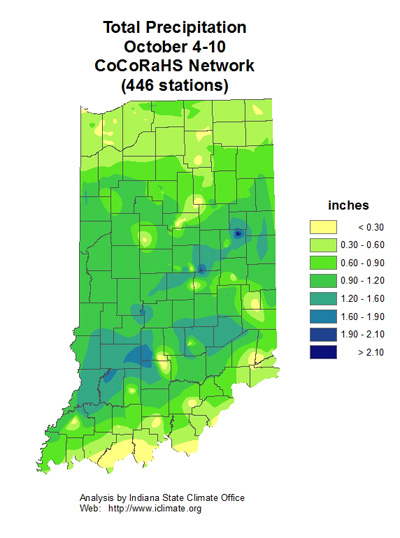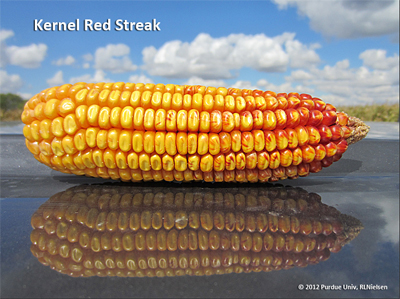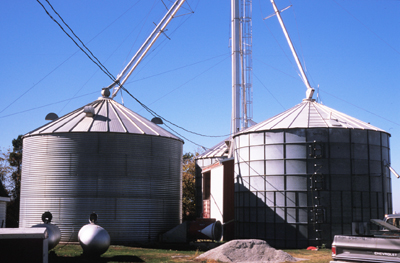Pest & Crop Newsletter, Entomology Extension, Purdue University
2012 Pest&Crop Reader Survey - Only your input can help us maintain and improve this publication! We would appreciate you taking a few moments to answer some questions concerning the Pest&Crop. Click here to begin the survey.
Indiana Weed Science Issues Induced by the 2012 Drought: Fall Edition - (Travis Legleiter and Bill Johnson) –
The 2012 drought obviously had effects on the corn and soybean crop yields and presented many challenges to producers as far as controlling weeds. The drought has also had lingering effects into this fall that could effect the wheat crop and potentially next year's corn and soybean crop. These challenges include potential herbicide carryover into this fall's wheat crop and next spring's corn and soybean crop, and the management of heavy volunteer corn stands prior to wheat planting.
Herbicide Carryover
The potential of herbicides applied this past summer to carryover into the wheat crop or next spring's corn and soybean crop cannot be addressed at a whole state level, as differences in recent rainfall amounts and soil types are too variable. The breakdown of soil persistent herbicides is dependent on soil properties, soil moisture, and soil temperatures. In general during a typical year in which soil moisture and temperature are near normal, rotational restrictions set by herbicide labels should be followed. The lack of soil moisture during a year of drought will decrease the rate of herbicide dissipation and carryover of certain herbicides may exceed the labeled rotational restrictions. Although the recent increase in rainfall over the past month has decreased the level of concern of herbicide carryover for a majority of the state.
Producers planning on planting wheat this fall have expressed concern regarding herbicide carryover. The largest concern is the carryover of atrazine and subsequent injury on wheat. Although it is a practice that has been commonplace it is off label to plant any crop other than corn or sorghum during the same calendar year of an atrazine application. Labels will vary on exact rotational restrictions to wheat, but the majority of the atrazine premix labels range from 14 to 15 months. The only exception is Lumax that does allow wheat rotation at 4.5 months after application. This being said, we cannot condone or advise on the planting of wheat in any year if atrazine was applied in the previous corn crop with the exception of Lumax applications at the labeled rate.
The other potential herbicide that may injure fall planted wheat would be fomesafen (Reflex, Flexstar, Dawn, and Rhythm) applied post in soybeans. The wheat rotational restriction for fomesafen products is four months after application. Late post application or rescue applications in soybeans could negate this four-month rotational restriction to wheat. Producers who applied a fomesafen product to soybeans this summer and have not seen significant rainfall following application (SW Indiana), should be aware of the potential for fomesafen injury on emerging wheat.
With the increased rainfall this fall and consistent warm soil temperatures the concern for herbicide carryover into next spring’s corn and soybean crop has declined dramatically. Producers who have not had these fall rainfalls should still be wary of atrazine and or HPPD inhibitor (Callisto, Laudis, Corvus, and Impact) carryover into soybean, especially in high pH and/or high clay content soils. Producers should also be aware of potential imidazolinone chemistry (Scepter and Pursuit) carryover into next years corn crop. Again the rains received this fall should have relaxed concern of herbicide carryover for the majority of the state, but those select areas where the drought was most severe and that are not receiving the fall rain events should still be wary of the potential for carryover.
Testing For Potential Herbicide Carryover
If you are concerned about carryover and would like to know the potential risk for injury to susceptible rotation crops you have two options: conduct a bioassay or have your soil analyzed for herbicide residues by a commercial lab.
A bioassay is conducted by planting susceptible crop seeds into your suspected soil and comparing growth and injury to plants planted in a non-herbicide treated soil. The use of a non-herbicide treated soil is key to avoid mistaking environmental stresses and insect or disease damage for herbicide injury. Keep in mind that soil types change across a field and multiple suspected soil samples should be tested to determine any hot spots in the field. A bioassay can be conducted in the field or soil samples can be placed in containers/buckets for closer observations and direct comparison to the non herbicide-treated sample. Conducting your bioassay in containers also allows you to easily water your soil samples and encourage plant emergence and growth of your susceptible crop.
The other option is to take soil samples from your suspected carryover fields and have them analyzed for herbicide residuals by a commercial lab. This is a rather expensive process and the results will likely be reported in a parts per million (ppm) format that is nothing more than a useless number if you are unaware of the safe to plant levels. A list of labs in the Midwest that will conduct herbicide analysis is listed below along with a table (Table 1) that lists the safe to plant levels for triazine herbicides.
Both bioassays and lab analysis should either be done in late fall or early spring to allow for maximum herbicide degradation and provide a more representative result of potential injury at planting.
Management of Fall Volunteer Corn
The effect of the drought on corn ear and kernel size can be observed by looking at a harvested corn field a couple of weeks following harvest. A large majority of fields are lush green with volunteer corn plants that emerged from grain that escaped the head rollers or combine sieves. Other than lost profit, a majority of producers will not be worried about these volunteer plants, as the winter freeze will eliminate the plants before next spring. Although producers wishing to plant wheat following a corn crop that did not receive atrazine (see above) will need to kill volunteer corn prior to wheat planting. Volunteers will likely be tolerant to glyphosate (Roundup) and/or glufosinate (Liberty) depending on the traits that were present in the previous crop. Volunteers from crops that were either Roundup Ready or Liberty Link only can be controlled with the alternate non-selective herbicide, but if the previous crop was stacked with both traits then herbicide options are limited. Fields containing volunteers following a RR/LL crop can only be controlled with applications of gramaxone or by tillage. Grass herbicides cannot be used to control volunteer corn prior to wheat planting as rotational restriction to wheat vary from 30 to 120 days. If choosing to apply Gramaxone, be aware that applications can result in variable control. Gramaxone is a contact herbicide and most be applied at higher spray volumes to achieve complete coverage. Even with complete coverage of volunteer corn plants can result in poor control as the growing point at or below the soil surface may survive the application. Fields containing heavy volunteer corn populations that are glyphosate and glufosinate tolerance would be best managed with tillage prior to wheat planting.
Commercial labs that offer soil herbicide residue analysis. Contact individual labs for pricing and specific soil sampling instructions.
A & L Great Lakes Lab
3505 Conestoga Drive
Fort Wayne, IN 46808
219-483-4759
http://www.algreatlakes.com/
AgSource Harris Laboratories
300 Speedway Circle
Lincoln, NE 68501
402-476-0300
http://www.agsource.com/
Agvise Laboratories
PO Box 510, 604 Hwy 15
Northwood, ND 58267
701-587-6010
http://www.agviselabs.com
Agvise Laboratories
902 13th St N
Benson, MN 56215
320-843-4109
http://www.agviselabs.com
APT Labs Inc.
1050 Spring St.
Reading, PA 19610
610 375-3888
http://www.aptlabsinc.com
Columbia Food Laboratories, Inc.
36740 E. Historic Columbia River Hwy
PO Box 353
Corbett, OR 97019
503-695-2287
http://www.columbiafoodlab.com/
Email: info@columbiafoodlab.com
Can test for herbicide residue in plant tissue.
Hazelton Environmental Services
525 Science Drive
Madison, WI 53711
608-232-3300
Midwest Laboratories
13611 B Street
Omaha, NE 68144
402-334-7770
http://www.midwestlabs.com
Minnesota Valley Testing Laboratories, Inc.
326 Center Street
New Ulm, MN 56073
800-782-3557
Fax: 507-233-7127
Email: mnsoil@mvtl.com
http://www.mvtl.com
Minnesota Valley Testing Laboratories, Inc.
51 L Ave.
Nevada, IA 50201
515-382-5486
800-362-0855
Fax: 515-382-3885
Email: mvtlia@mvtl.com
http://www.mvtl.com
Montana State Analytical Laboratory
McCall Hall
PO Box 173620
Montana State University
Bozeman, MT 59717
406 994-3383
South Dakota Agriculture Laboratories
Brookings Biospace
Dr. Regina Wixon,
Email: regina.wixon@sdaglabs.com
1006 32nd Ave #103 / #105
Brookings, SD 57006-4728
605-692-7325,
http://www.sdaglabs.com
| Table 1. Safe to plant levels for triazine soil residue lab results. | ||
| Triazine residue level (ppm) | Crops "safe" to plant | |
| 3 inch sample (no-till) | 6 inch sample (moldboard plow) |
|
| Less than 0.17 | Less than 0.08 | Oats and alfalfa |
| 0.17 to 0.35 | 0.08 to 0.017 | Soybean |
| Greater than 0.35 | Greater than 0.017 | Corn |
Wheat Planted in Corn Stubble at Risk for Head Scab – (Kristen Wise and Charles Woloshuk, Ag Answers) –
More corn acres brought on by high corn prices in recent years could tempt winter wheat growers to plant the crop into corn stubble, but a Purdue Extension pathologist says the practice puts wheat at risk for head scab development.
Head scab, or Fusariam head blight, is caused by the fungus Gibberella zeae, also known as Fusarium graminearum, which is harbored in corn residue. In corn, the fungus causes ear and stalk rots, and in wheat can lead to yield loss and reduced grain quality. The disease also produces a mycotoxin called deoxynivalenol, also called DON or vomitoxin, which is toxic to humans and livestock.
“There is a yearly concern for wheat planted into corn stubble because the fungus that causes head scab also causes Gibberella ear rot in corn,” Kiersten Wise said. “Even though this was a year when we didn’t have a lot of Gibberella ear rot, there were some reports of it, and fields with wheat following corn would be at risk in those situations.”
Gibberella zeae can overwinter in corn residue and produce spores in the spring. High humidity and frequent rainfall in the spring can help disperse the spores to wheat plants. Wheat is most susceptible to infection during growth stages between flowering and dough.
Wise said winter wheat growers could lower the risk by planting the crop in fields that produced non-host crops, such as soybeans.
“Our initial recommendation is to not plant wheat after corn, but we know that’s a practice that a lot of growers are going to do,” she said. “So what we would recommend is that they select a variety that has resistance to Fusarium head blight, or scab. Next spring they need to pay attention to the weather as wheat starts to flower and decide if they need to apply a fungicide to manage scab.
“No single disease-management tactic will provide adequate control of this disease, especially if environmental conditions favor disease development.”
More information about head scab in wheat is available in Purdue Extension’s publication, “Diseases of Wheat: Fusarium Head Blight (Head Scab)” at <http://www.extension.purdue.edu/extmedia/BP/BP-33-W.pdf>. The publication, authored by Wise and Purdue Extension plant pathologist Charles Woloshuk, includes information about identification, mycotoxin tolerance levels, safe grain handling, disease management and more.
Other related publications can be found at Purdue Extension’s The Education Store at <http://edustore.purdue.edu>.
Kernel Red Streak in Corn – (Bob Nielsen) –
Kernal red streak, or KRS, is a phenomenon wherein streaks of red pigments radiate throughout the pericarp of an otherwise yellow kernel. On a bright, sunny day, the combination of red and yellow is strikingly beautiful. The occurrence of kernel red streaking does not seem to restrict itself to fields of “good” corn or “bad” corn. Some hybrids seem to exhibit KRS more often than others, but those may simply be random chance observations.
The KRS symptom was apparently first documented in 1963 in fields throughout northeast Indiana, southern Michigan, and northwest Ohio (Anonymous, 1963) and in Ontario in 1964 (Wall & Mortimore, 1965). By 1966 (Williams, 1966), researchers had begun to associate the KRS symptom with the concomitant presence of the wheat curl mite (Aceria tulipae K.; aka Aceria tosichella Keifer), a pest in wheat and vector of the wheat streak mosaic virus (WMSV). Researchers in South Dakota reported in 1969 that KRS could be caused by artificially infesting kernels with wheat curl mites during the grain filling period. The severity of the KRS development was more severe with infestations of mites carrying the WSMV, but also occurred with infestations of virus-free mites.
Earlier research (Nault et. al., 1967) had suggested that the WSMV was not the cause of the red streaks, but rather the pigmentation resulted from “salivary phytotoxins” secreted by the mites as they fed on the pericarp of kernels. Their work was confirmed by research published from Ontario a year later (Slykhuis et al., 1968). Much later research from Ontario documented the correlation between wheat curl mites and incidence of KRS; as well as the relationship between distance from mite-infested wheat fields and incidence of KRS in adjacent corn fields (Liu et al., 2005).
Growers often worry that the red streaks may signify the presence of ear molds or toxins, but there is no such documented relationship. The most frequent concern with KRS occurs with food grade corn grown under contract for snack food processors. While purely cosmetic, the red pigmentation in the pericarp can discolor the finished products (e.g., corn chips, tortilla chips, taco shells) and, apparently, deter some customers. This appears to be especially true for the wet milling industry wherein the pericarp is not always removed prior to the alkaline cooking process and the remaining pigmented pericarp pieces can turn black with the cooking. Thus, the snack food industry is not keen on purchasing corn grain with high levels of KRS.
Trivia: Though not part of the official grade requirements for corn, the U.S. Standards for Corn <http://www.gipsa.usda.gov/fgis/standards/810corn.pdf> define “yellow corn” as corn that is yellow-kerneled and contains not more than 5 percent of corn of other colors. “White corn” is similarly defined as corn that contains not more than 2 percent of corn of other colors. Grain that does not meet either of these definitions is defined as “Mixed corn." Specifications for food grade corn grain usually refer to #1 yellow or white dent corn.
I have yet to find any research that offers an alternative cause of KRS in yellow dent corn. However, research published by Lee et al. (2009) describes a similar, but reportedly unrelated, phenomenon in white corn that they defined as purple kernel streak (PKS). They distinguished the purple pigmentation of PKS (caused by anthocyanins) from the red pigmentation of KRS (caused by phlobaphenes) and identified different genetic pathways that control the development of the pigments. Their paper suggests that cold temperatures late in the grain filling process may trigger the formation of the anthocyanin pigments in the kernels of sensitive white corn hybrids.
Related Reading
Anonymous. 1963. MSU, USDA analyze “red-stripe” corn in Mich-Ind-Ohio. Seed Trade News 81: 24.
Lee, E.A., J.A. Young, F. Azizi, S. Jay, and A.W. Schaafsma. 2009. Phenotypic and Genotypic Characterization of Purple Kernel Streak in White Food Corn. Crop Science 49(4): 1235–1241.
Liu, J., E.A. Lee, M.K. Sears, and A.W. Schaafsma. 2005. Wheat Curl Mite (Acari: Eriophyidae) Dispersal and Its Relationship with Kernel Red Streaking in Maize. Journal of Economic Entomology 98(5): 1580–1586.
Nault, L.R., M.L. Briones, L.E. Williams, and B.D. Barry. 1967. Relation of wheat curl mite to kernel red streak of corn. Phytopathology 57: 986–989.
Slykhuis, J.T., C.G. Mortimore, and L.F. Gates. 1968. Kernel Red Streak of Corn in Ontario and Confirmation of Aceria tulipae (K.) as the Causal Agent. Can. J. Plant Sci. 48(4): 411–414.
Townsend, Lee, Doug Johnson, and Don Hershman. 1996. Wheat Streak Mosaic Virus and the Wheat Curl Mite. Univ of Kentucky Extension publication ENTFACT-117. Online at <http://www.ca.uky.edu/entomology/entfacts/ef117.asp> [URL accessed Sep 2012].
Tunac, J.B., and Nagel, C.M. 1969. Kernel red streak of dent corn. Plant Disease Reporter 53: 660–662.
Wall, R.E., and C.G. Mortimore. 1965. Red striped pericarp of corn. Can. Plant Dis. Survey 45: 92–93.
Williams, L.E. 1966. Kernel red streak (KRS) of corn. Proceedings of the Annual Hybrid Corn Industry-Research Conference 21: 18–22.
Post Harvest Update and Recertification Workshop - (Linda Mason)
The Post Harvest Update and Recertification Workshop will be held November 28, 2012 at the Beck Agricultural Center, Purdue Agronomy Center for Research and Education, 4540 U.S. 52 W., West Lafayette, IN 47906.
Pre-register and save money, $95.00 by Nov. 23 and $110.00 after. Registration is limited. The schedule of the day:
8:30 AM - Registration, Coffee & Donuts
9 AM - 12 PM - Sessions
12 - 12:30 PM - Catered Lunch Provided
1 - 4 PM - Sessions
4 PM - Complete Certification Forms
CCH’s have been applied for. Watch for more detail on our Post Harvest and Grain Quality Website: <http://extension.entm.purdue.edu/grainlab/>.







